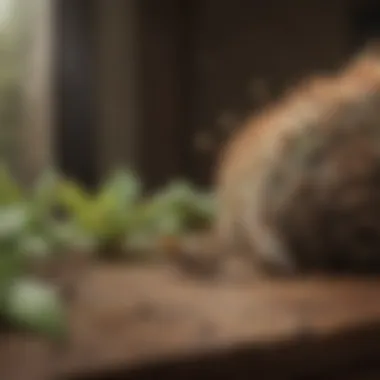Effective Strategies to Eliminate House Moths


Intro
House moths, often seen as a mere nuisance, can wreak havoc on your home. They are not only annoying but can cause real damage to textiles and stored food. Understanding how to identify these pests is crucial. When you recognize the signs of infestation early, you can take action before they do extensive harm. This article is a targeted guide for homeowners and design enthusiasts who seek to maintain a beautiful, secure living space. We will explore effective strategies for identifying, preventing, and eliminating moth infestations while evaluating both natural and chemical solutions. Additionally, we provide insights into creating a moth-free environment through maintenance practices.
Design Inspiration
In an effort to maintain an appealing home interior, it is essential to protect your textiles and aesthetic elements from moth damage. Moths tend to infest clothes, carpets, and fabrics. Their presence can lead to unsightly holes and major disappointments. Therefore, understanding design in relation to pest management can be beneficial.
Trending Styles
In recent years, eco-friendly designs and materials have gained popularity. Natural fibers like wool or cotton attract moths. Opting for synthetic materials for certain items, such as furniture upholstery or area rugs, may help reduce risk. When selecting textiles, consider treatments that provide moth resistance. This aligns your design preferences with practical needs, ensuring a stylish yet safe home environment.
Color Palettes
Choosing colors that camouflage potential moth damage can lessen the visual impact of small holes or wear. Soft, darker hues may disguise any minor imperfections, allowing you to maintain the overall aesthetic. Light shades, however, can expose damage more prominently. Keeping this in mind while selecting home textiles may contribute to a more durable and visually appealing interior.
Practical Tips
Defeating moths requires dedication. Implementing the right strategies can lead to successful outcomes in controlling infestations.
Maintenance & Care
Maintaining a moth-free home involves regular cleaning and care routines. Consider these essential tips:
- Vacuum regularly: Pay special attention to carpets, rugs, and upholstery. Vacuuming removes moths and their eggs.
- Wash textiles: Regularly wash clothes and linens in hot water. Dry cleaning is also effective for delicate items.
- Store items properly: Use airtight containers for seasonal clothing and blankets. Moths cannot penetrate sealed storage.
Budgeting & Planning
Preventing moth damage does not have to be costly. Simple budget-conscious practices can protect your belongings:
- Create a maintenance schedule that outlines regular cleaning tasks.
- Set aside a small budget for pest control products, such as essential oils or traps.
- Invest in high-quality storage solutions to keep items safe.
It is vital to create a comprehensive moth prevention plan. This plan should include both short-term actions and long-term solutions.
By integrating these tactics into your daily routine, you can effectively combat moth infestations. A real focus on prevention and maintenance will enhance your ability to protect your home. With an emphasis on practical solutions and understanding the nature of these pests, homeowners can achieve and sustain a moth-free environment.
Understanding House Moths
Understanding house moths is crucial for homeowners and those interested in interior design. These pests can cause extensive damage to textiles and food supplies. Recognizing their characteristics and habits can aid in devising effective strategies for management and prevention.
Classification of House Moths
House moths are classified into two main categories: clothes moths and food moths. Identifying which type infests your home assists in targeting eradication methods effectively.
Clothes Moths
Clothes moths are primarily known for their preference for animal fibers found in clothing. The key characteristic of clothes moths is their larval stage, where they feed on fabrics containing keratin. This makes them a significant concern for anyone with valuable textiles. Their ability to create small holes in clothing can lead to irreparable damage. The advantage of understanding clothes moths is being able to preemptively treat areas likely to be affected, which can save homeowners from costly losses.
Food Moths
Food moths, often referred to as pantry moths, target stored food products. Their most notable characteristic is their attraction to grains, nuts, and dried fruits. This poses a risk not only to food safety but also to hygiene. Understanding food moth behavior aids in creating better storage solutions, preventing contamination. The unique feature of food moths is their rapid reproduction ability, making prompt action vital once they are spotted.
Life Cycle of House Moths
The life cycle of house moths consists of four distinct stages: egg, larva, pupa, and adult. Knowing this cycle can help in pinpointing the most effective intervention strategies at each stage.
Egg Stage
The egg stage is where the cycle begins. Females lay tiny eggs in hidden areas, often near food sources or fabric. This stage contributes significantly to overall moth populations since a single female can lay dozens of eggs. Recognizing the signs of eggs can lead to early intervention, which is crucial for controlling infestations.
Larval Stage


During the larval stage, the caterpillar-like larvae emerge and begin to feed. This is the most damaging stage, especially for clothing and food items. They can live for several months, meaning they can cause extensive damage before becoming adults. Understanding this stage is beneficial, as it highlights the importance of targeted treatments to disrupt their feeding.
Adult Moths
Adult moths are often observed fluttering around lights. They are mostly inactive during the day and are primarily nocturnal. This stage is less destructive than the larval phase; however, it poses a risk of laying more eggs. Recognizing adult moths can help in identifying the presence of an ongoing infestation. Their presence in your home can act as a warning sign to check for further evidence of larvae or eggs.
Common Signs of Infestation
Identifying signs of an infestation is essential for timely intervention. Several indicators can alert you to the presence of moths in your home.
Damage to Fabrics
One of the most evident signs of infestation is damage to fabrics. Holes in clothing or furnishings can signal moth activity. Understanding what damages look like can help homeowners take immediate action. Regular inspections can safeguard valuable items by catching infestations early.
Presence of Webs
Another common sign is the presence of webs. These webs, created by larvae, can often be found in dark corners or hidden areas. Knowing where to look for webs can guide effective measures to eliminate moths. Despite being unsightly, webs can serve as a clear indicator of an infestation that needs addressing.
Adult Moths in Light
Seeing adult moths attracted to light sources also indicates an issue. Adult moths are drawn to light, which can highlight their presence. Timely identification of adult moths allows for prompt measures to stop reproduction and further infestation.
If you notice any signs of moths, it's best to act quickly to prevent damage and further breeding.
Identifying Infested Areas
Identifying infested areas is a crucial step in addressing moth problems effectively. Understanding where moths tend to hide helps in targeting extermination methods and preventative measures. House moths often occupy specific spaces in your home, which can lead to extensive damage if left unattended. Knowing these areas not only aids in quick identification but also ensures that infested spots are treated promptly, reducing the risk of widespread infestation.
Common Hiding Spots for Moths
Closets and Wardrobes
Closets and wardrobes are prime locations for moth infestations. The dark and enclosed nature of these spaces provides a sanctuary where larvae can thrive. Fabrics, such as wool or silk, attract moths due to their fibers, which serve as a food source during the larval stage.
A unique feature of closets is their limited airflow, allowing humidity to increase. This further encourages moth activity. Regularly checking your closets helps in early detection of moth damage, ensuring that the problem does not escalate. The disadvantage, however, can be the time-consuming process of sorting through items, especially larger wardrobes.
Pantries and Food Storage
Pantries and food storage areas are another significant concern for moth infestations. Food moths, such as Indian meal moths, can contaminate grains, cereals, and dried fruits. Their ability to sneak into sealed packages makes them a challenge to control. These areas often have a combination of warmth and an abundance of food sources, which moths find appealing.
Keeping track of expiration dates and ensuring that containers are sealed tightly can aid in mamaging this issue. However, regular inspections are necessary, as moths can quickly multiply if undetected, jeopardizing food hygiene and causing monetary loss due to wasted products.
Attics and Basements
Attics and basements are often forgotten spaces that are also commonly infested. The lack of frequent human activity in these areas allows moths to establish themselves unnoticed. Old clothing items or stored textiles in these spaces are perfect feeding grounds for larvae. Increased humidity can also lead to mold alongside moth infestations.
The unique characteristic of attics and basements is their temperature fluctuation, which can invite different pests. Regular checks are essential here, too, although cleaning these areas can be dreary due to dust and clutter. Proper storage solutions and clean environments can significantly diminish the likelihood of moth problems.
Using Traps for Identification
Using traps can simplify the identification of moth infestations. Specific traps can help diagnose which types of moths are present, giving insights into effective treatments.
Pheromone Traps
Pheromone traps are incredibly useful for identifying specifically attracted moths. These traps utilize synthetic chemicals that mimic the natural scents of female moths, luring males to them. Once trapped, these moths signal a problem, allowing homeowners to take timely action.
The key characteristic of pheromone traps is their specific targeting; they can help distinguish between different moth species. This method is environmentally friendly and simple to use, requiring little maintenance. However, they do not eliminate populations; they only inform about the presence of moths.
Sticky Traps
Sticky traps are another efficient tool for moth identification. These traps are coated with an adhesive that captures any moths that land on them. The effectiveness lies in their widespread appeal to various flying insects, not just moths. By placing them in suspected infested areas, you can not only catch moths but monitor their activity over time.
While sticky traps are easy to set up and monitor, they may need to be replaced frequently due to dust accumulation or saturation by other insects. This can become an inconvenience for users, but they are still a vital option in monitoring infestations.


Natural Methods of Eradication
Natural methods of eradication are essential for homeowners looking to eliminate house moths without relying on synthetic chemicals. This section explores various natural solutions, providing insights into their effectiveness and safety. These methods have the added benefit of being environmentally friendly, making them a preferable choice for many. Understanding these alternatives can empower homeowners to maintain a pest-free environment while being mindful of health and ecological considerations.
Essential Oils
Lavender
Lavender is an essential oil known for its pleasant scent and natural pest-repelling properties. It effectively masks the odors that attract moths, making it easier to deter them from invading your home. The aromatic oils found in lavender act as a natural insect repellent by disrupting moth communication. This characteristic is what sets lavender apart as a strong contender in insect management.
Using lavender in your home can take various forms, such as added to homemade sprays, diffused, or simply placed in sachets. One advantage is its dual function; while it repels pests, it also adds a calming aroma to living spaces. Some may find its fragrance overwhelming, especially in large quantities. Therefore, using it in moderation ensures you enjoy both its scent and protective qualities.
Peppermint
Peppermint oil is another powerful natural repellent. Its strong smell deters many unwanted insects, including moths. This vigorous scent disrupts the moths' sense of smell, causing them to avoid the affected areas. Peppermint's anti-pest properties are well recognized, making it a popular choice among those seeking a natural solution.
Utilizing peppermint oil can involve spraying a solution diluted in water around potential infestation sites. The unique feature of peppermint is its invigorating aroma, which can be refreshing to some. On the downside, some people might find the minty smell too potent or strong for their preferences. Adjusting the concentration in your mixture can help mitigate this issue while still maintaining its repellent effects.
Herbal Solutions
Bay Leaves
Bay leaves are not only a culinary herb but also serve as a natural moth deterrent. Their strong scent is unappealing to moths and can help prevent infestations. The key characteristic of bay leaves is their natural oils, which give off an aroma strong enough to keep moths at bay. Incorporating bay leaves into your pest control strategy makes it an affordable and practical choice.
Placement of bay leaves in cupboards or closets can be an effective way to safeguard stored textiles and food items. The unique feature of bay leaves is their longevity; they remain effective for a long period. However, they may lose potency over time, meaning regular replacement is necessary for sustained effectiveness.
Sachets of Dried Herbs
Creating sachets filled with dried herbs is another classic method to ward off moths. Common herbs to include are thyme, rosemary, and mint, which possess qualities similar to lavender and peppermint. The key advantage of these sachets is their aesthetic appeal and versatility. They can be placed in drawers, closets, or even hung in various locations throughout a home.
Dried herb sachets also allow homeowners to customize scents according to personal preference. However, they do require occasional refreshing, as the aromatic oils dissipate over time. This maintenance can be seen as a disadvantage but is also simple to address by replacing the sachets with new herbs when needed.
Diatomaceous Earth
Application Methods
Diatomaceous earth is a non-toxic powder that can be an effective solution against moths and other pests. The primary method of applying it involves dusting the powder in areas where moths are prevalent, such as cracks, crevices, and around possible entry points. This application is relatively straightforward, making it easy for homeowners to use.
The key characteristic of diatomaceous earth is its mechanical action. The tiny particles draw moisture from insects, leading to their eventual desiccation and death. This unique feature ensures that it targets pests without harming the environment. One drawback is that it can be messy to apply and may require repeated applications for effective long-term control.
Effectiveness
Diatomaceous earth is known for its effectiveness in controlling various pests, including house moths. Its long-lasting properties make it an attractive option for sustained pest management. However, its effectiveness depends on proper application. If not applied correctly, it may not yield desired results, which is a consideration for any user.
Additionally, diatomaceous earth should not be directly inhaled, as it can be harmful to the lungs. Despite this precaution, it remains a popular choice due to its natural origin and effectiveness in pest control.
In summary, integrating these natural methods into your pest control routine allows for effective moth eradication while ensuring safety for your home, family, and the environment.
Chemical Solutions and Pesticides
Chemical solutions and pesticides are often seen as essential tools in tackling house moth infestations. Their significance lies not only in their effectiveness but also in the speed with which they can help control a growing problem. Moths can quickly damage fabrics and food, so having reliable methods to combat them becomes crucial. Chemical solutions can provide immediate results, particularly in severe cases.
Insecticides
Types of Insecticides
Different types of insecticides exist to combat house moths. These products can be divided into synthetic and natural options. Synthetic insecticides, such as permethrin, are popular for their rapid action and proven effectiveness. They target the nervous system of insects, leading to quick elimination. On the other hand, natural insecticides, like neem oil, offer a more eco-friendly alternative. While they may require a bit longer to use, they minimize chemical exposure in the home.
Each class of insecticide has its own characteristics that make it suitable for various situations. For those seeking quick eradication, synthetic insecticides often stand out. However, natural products can be appealing to homeowners who prioritize safety and sustainability.
Application Guidelines


Proper application of insecticides is essential for their effectiveness. Always read the instructions provided by the manufacturer. Coverage should be thorough to ensure all areas where moths may hide are treated. Moreover, applying insecticides early in the morning or late in the evening often yields better results, as moths are more active at these times.
A noteworthy characteristic of application guidelines is that they not only provide dosage information but also set safety protocols. Mistakes in application can lead to ineffectiveness or harm to humans and pets. Clear guidelines ensure that the insecticide is used properly, maximizing its benefits. One unique aspect is the recommendation to ventilate spaces after application, reducing inhalation risk.
Safety Considerations
When using chemical pesticides, safety considerations are of utmost importance. Understanding how these products affect the environment and your household is essential.
Use around Children and Pets
The impact of insecticides on children and pets cannot be overstated. It is critical to choose products that are specifically labeled as safe for use around vulnerable populations. Parental guidance is vital for ensuring that children do not come into contact with treated areas until they are deemed safe.
A key characteristic of insecticides is their potential toxicity. This makes selecting low-risk products crucial when homes have young children or pets. Following safety protocols reduces health risks and enhances overall effectiveness. However, many homeowners might not know the right approaches to take, so consulting product labels can be very helpful.
Environmental Impact
The environmental impact of chemical solutions is another significant aspect to consider. Many homeowners are concerned about the side effects of harsh chemicals on local wildlife and household plants. Choosing eco-friendly options minimizes the risk of adverse environmental effects. Natural insecticides may take longer to work but often present a lesser environmental risk.
A unique feature of considering environmental impact is researching the insecticide's ingredients. Not all products are created equal, and some can cause substantial harm if misused. It is crucial to weigh the urgency of moth control against potential environmental consequences to make informed decisions.
Chemical solutions can be effective, but understanding the risks and following guidelines are essential for safe usage.
By judiciously applying chemical solutions and pesticides alongside safety precautions, homeowners can effectively combat moth infestations while safeguarding their households and environment.
Preventative Measures
Preventing house moth infestations is critical for maintaining a healthy and clean environment. Once moths infiltrate, they can cause significant damage to textiles and food. Proactive measures can help minimize this risk. By focusing on proper storage, regular cleaning, inspections, and the use of natural repellents, homeowners can protect their space from these pests.
Proper Storage Techniques
Sealable Containers
Sealable containers play a vital role in safeguarding your belongings from moth damage. Their design helps to create an airtight environment that deters moths from accessing food and fabric items. A key characteristic of sealable containers is their robust material, typically plastic or glass, which can protect contents from both moths and moisture. This feature is beneficial as it reduces the likelihood of infestation in stored goods. One unique advantage of sealable containers is that they not only keep moths out but also preserve the quality of food and textiles over time. However, it is essential to note that adequately cleaning items before placing them in these containers is necessary for optimal results.
Regular Cleaning
Regular cleaning is a fundamental practice for moth prevention. Maintaining cleanliness in your home discourages moths from settling down. A key aspect of this cleaning is the removal of dust and debris where moths might nest. Regular cleaning is beneficial because it targets potential breeding grounds before they become infested zones. A unique feature of this approach is the need for thorough inspections during the cleaning process; this ensures that any signs of moths can be detected early. While time-consuming, the advantages of regular cleaning include not only moth prevention but also a more hygienic living environment overall.
Monthly Inspections
Routine Checks
Routine checks are essential in the fight against moth infestations. This aspect focuses on the regularity of inspecting common moth-prone areas in your home. A significant characteristic of routine checks is their systematic nature, allowing homeowners to keep track of their monitoring efforts. Conducting these checks monthly can help identify early infestations and prevent them from spreading. The benefit of routine checks lies in the peace of mind they provide. You can be proactive rather than reactive when it comes to home maintenance. Moreover, while it may seem burdensome, making time for these inspections can save considerable trouble in the long run.
Earliest Signs of Moths
Identifying the earliest signs of moths is crucial in preventing a full-blown infestation. This aspect involves recognizing the indicators, such as small holes in clothing or the presence of webs. A key characteristic of being alert to these signs is that it fosters a proactive approach to pest control. Recognizing these signs early on can significantly contribute to your overall goal of keeping a moth-free home. The unique advantage here is that early detection often translates to easier, less expensive interventions than waiting for the problem to escalate.
Use of Natural Repellents
Creating a Moth-Free Environment
Creating a moth-free environment entails utilizing natural repellents effectively. This aspect emphasizes the importance of maintaining an atmosphere that is hostile to moths. One key characteristic of this approach is the incorporation of natural substances like essential oils or herbs, which are known to repel moths. This strategy is beneficial for homeowners seeking chemical-free methods to protect their belongings. The unique feature of creating a moth-free environment is its sustainability; once established, it requires minimal effort to maintain.
Regular Use of Repellents
Regular use of repellents is essential for effective moth control. This practice focuses on the consistency of applying natural repellents to keep moths at bay. A significant aspect of this approach is the routine application of substances such as lavender or cedar, which are popular in creating a repellent barrier. The benefit of regular use lies in its proactive nature, which helps establish a lasting protective measure. However, homeowners should be aware that the effectiveness of these repellents can diminish over time, necessitating periodic reapplication. This careful balance is crucial for sustaining a moth-free home.
End
In this article, we explored the various dimensions of house moth control. The importance of addressing moth infestations cannot be overstated. Inadequate attention to this issue can lead to substantial damage to fabrics and stored food items, affecting both aesthetics and food safety in a home. Understanding the life cycle and behavior of house moths is critical to developing effective strategies for prevention and eradication, ensuring that your living space remains safe and free from harm.
Summary of Key Points
House moths can infiltrate homes through various routes, leaving behind destructive traces. As we examined, the initial step is identifying the afflicted areas. Recognizing common hiding spots such as closets, pantries, and attics is crucial for effective control. Once identified, both natural and chemical methods of eradication are available, each with their unique advantages. Moreover, establishing preventative measures through proper storage and regular inspections proves invaluable in mitigating future infestations.
Final Thoughts on Moth Control
Maintaining a moth-free environment is an ongoing responsibility for homeowners. Regular vigilance regarding cleaning and storage habits forms the backbone of an effective strategy against moths. Additionally, embracing both natural and chemical solutions based on specific needs allows for a tailored approach to moth control. This balanced perspective on eradication and prevention ensures not only immediate results but also long-term peace of mind. By investing effort into this challenge, homeowners can protect their properties and enjoy a moth-free life.















